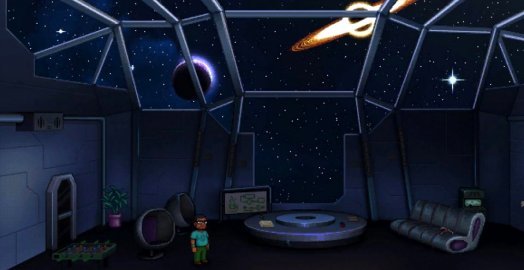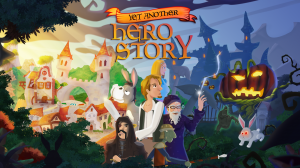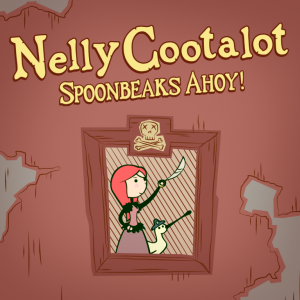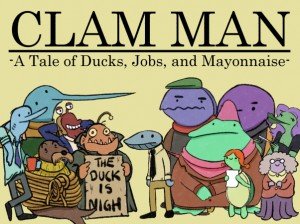Review for Odysseus Kosmos and his Robot Quest

Haunting music plays as a 457G class ship gently moves through the pixel-drawn Gargan system in deep space, stars twinkling in the background with a giant black hole in close proximity. Inside the large spacecraft is Odysseus Kosmos, a lazy, corner-cutting engineer with an unhealthy obsession with donuts, who has been left all alone by his crewmates with the sole task of keeping the vessel operating. Oh, and there’s his oddly named robot companion, Barton Quest, to keep him both sane and on-task. Together they spend their days performing routine maintenance, usually through repairing the seemingly endless number of ship systems that continually break down. This starts to feel a little monotonous after a while, compounded by decidedly over-written dialogue between the two protagonists. Fortunately, the retro-style graphics are fun, and the story does eventually pick up and go some interesting places before all is said and done.
Upon starting Odysseus Kosmos and his Robot Quest, this is pretty much all you know. As you progress through its five episodes, however, you’ll gradually uncover a deeper story with many twists and turns, along with an intriguing backstory to the titular protagonist, who, it turns out, isn’t the boring two-dimensional character he first appears. Normally I would go into a lot more detail about the plot, but with Odysseus it’s extremely difficult because the story moves along at such a slow pace that to reveal more would literally be describing events that don’t occur until well into the third chapter. What I will say is that the narrative does eventually become interesting and mostly satisfying, although it is also fairly predictable if you have any familiarity with time-distortion sci-fi.
Odysseus – Oddy for short – is the engineer on the San Francisco, his only task being to maintain the ship while the rest of the crew are off on a mission. That mission, you discover soon enough, is on a planet that is near the black hole you’re orbiting and is experiencing major time dilations. In short, what is mere minutes for the crew could turn out to be longer than Oddy’s natural life span. (Think Christopher Nolan's Interstellar.)
Oddy isn’t what you would expect from an engineer. He’s capable, but unmotivated. His sole focus seems to be eating, and when he is called on to repair something, he might not bother to fix it properly, instead doing just enough for the moment and hoping that it will hold up for the long haul. He also has a marked capacity for misplacing things that he just might need to solve the next puzzle.
His frustrated robot friend Barton Quest is the voice of reason on the ship. He’s the one who advises Oddy what needs to be fixed and offers advice at times. This is a character that could have been inserted simply for the protagonist to talk to, but instead he actually serves a practical purpose as well, such as one puzzle in which Barton helps repair a broken circuit. In Episode 3, Barton becomes a playable character and it is Oddy on the other end of the speaker giving advice. It’s a nice turnaround that keeps things fresh. If you’re a Sierra fan from years gone by, think of Barton as Cedric the Owl in King’s Quest V, except useful.
The vast majority of what you learn about events transpiring around you, at least in the first three chapters, comes from either introspection on the part of Odysseus or from the interaction between the two main characters. The latter is where the first major disappointment of the game lies: the dialog is tedious.
While the plot itself has a good hook and is interesting enough to keep you wanting to know more, you’ll be tempted to stop reading when the dialog starts. The banter between Oddy and Barton is over-written and misses the mark in its comedy and timing, something that might have been at least partly fixed with real voice work. There’s a gem of a good idea here, as the dynamic between the pair is amusing, including Barton being frustrated at Oddy’s laziness and Oddy not caring. It’s just hard to stay engaged. Simply put, the majority of conversations are boring and repetitive. A great example of this is during the introductory chapter, where the entire exchange revolves around donuts and Oddy’s love for them. While it’s a nice little personality quirk, it’s just not funny enough for the amount of time devoted to it. Another issue with the subtitled text is the grammar. “To” and “too” mean different things and apostrophes are important. They’re little things but it’s something that could easily have been improved with proper editing.
There are others who appear in later chapters, but they all seem to exist to serve a particular purpose, usually a thinly-veiled roadblock to your progress rather than being distinctive characters for Oddy to interact with. One I found particularly annoying is a nurse in the final episode who needs to give you a physical examination yet is too tired to do it. Another character, Sam, also succumbs to the tedious dialog present throughout, although his portion of the game – a flashback to Oddy’s childhood – is very well presented and an enjoyably surprising diversion.
Puzzles are largely of the standard fetch-and-use variety. The primary task in the first installment is to repair what seems to be an endless stream of mechanical problems, made worse by the strange gravitational force of the black hole just outside. Fixing something might be as simple as getting a component from the ship supplies and placing it in a machine, or gathering a number of items to restore your broken clock radio. While most of these obstacles are reasonably logical, there are some strange combinations that only old-school adventure game fans would appreciate, like using a rubber duck, back scratcher, or a mouse (the animal, not the computer accessory) to resolve a dilemma, which will take some trial-and-error until stumbling on the solution.
The rest of the game largely continues in this routine manner. Most objectives are based around either repairing or activating things on the ship to solve a problem. An example of this is in the third chapter where you are required to get a large electro-magnet working. It isn’t broken this time, but you do have to set it up and use it in a particular way to bypass the current obstacle. The final episode is the odd one out in this regard, with the quests being very dialog-driven towards the end, although the reality for the player is essentially the same: go to this particular person and find out something to tell another person. At least there are some highlights sprinkled in. One puzzle of note involves a flashback to young Oddy learning to shoot a target with a slingshot accurately. As well as being a well-designed puzzle in putting all the pieces of the solution together, it also shows some character development of our hero in how he underhandedly approaches the challenge. It’s a rare piece of personal insight in the game and is very nicely handled.
Along the way you’ll find yourself interacting a lot with your onboard computer terminal’s SanFran.net. Logging in brings up a classic retro display, all black and green, which tells you what your current task is. There are a few of these terminals throughout the ship and they serve both as a plot device and a convenient quest log. One very early quest involves getting your misplaced screwdriver from on top of an intercom speaker, and doing so actually involves using SanFran.net in a very tangible way.
There are a number of close-up puzzles as well that add variety to the mix. These usually represent the climax of a particular system repair and might require fixing a broken wire or assembling pieces in a Tetris-style minigame. None are very complicated, but they do provide a small challenge before advancing the story. Another nicely implemented puzzle involves a GameBoy you are given to play by your brother Sam in one of the flashback scenes of Oddy’s childhood. You’re required to complete the two levels that the owner can’t before he gives you the item you need. It’s a nice little diversion of the escape-the-maze variety that successfully brings to mind the classic early handhelds and their simple black and white displays.
Of the increasing number of adventure games that use retro pixel graphics, Odysseus Kosmos stands above many of them. The spaceship is generally presented in off-white or metal shades, but the artists have given it a definite lived-in look. In the engineering section, the first main area encountered, there’s a lot of colour livening up the screen, with plants growing and some scientific equipment that also forms the first set of puzzles to solve. One area of notable impact is the recreation room, which has an exposed back wall showing the black hole and space view in all its glory. Among the sofas, armchairs and foosball table is a whiteboard with a drawing that looks suspiciously like a certain rabbit from classic LucasArts. As the game progresses, further areas open up but the majority of your time is still spent within the confines of the ship, although some exterior scenes such as family home and garden are also well-drawn and the change to a more natural palette is visually pleasing.
While the background aesthetic stands out, the animations are a bit of a letdown. Oddy himself only ever faces left or right at a slight downward angle. This doesn’t present a major problem since none of the rooms are too deep, but on those occasions when he does walk forwards or backwards, it becomes quite noticeable. There’s also a lack of context-specific animations to show what Oddy is doing. In one of many such examples, the recreation room has a puzzle where you are required to stand on Barton’s shoulders, but Oddy is never shown climbing up, the game just fading to black and resuming with Oddy on top.
A magnificent song is performed over the opening montage, which really sets a melancholy and lonely feeling for the adventure and is a definite musical highlight. Each room has its own suitably sci-fi track playing in the background, none of them overbearing or detracting from the experience. In the close-up puzzles the score has a distinctly nervous feel, which sets you on edge a little and gives these events more impact. It doesn’t appear that any of the tasks can actually be failed, but it is certainly a nice way of adding some tension to a game that otherwise has very little.
Instead of being fully voiced, all the characters speak in what would best be called Simlish. It’s garbled nonsense, completely unintelligible, but it does create the effect of actual conversation taking place. Made popular in The Sims games, it’s not used in adventures often and its effectiveness here is really going to be a matter of personal opinion. You’ll either like it or loathe it. Personally, I don’t mind it and the recording quality is good, although I did check my language settings to make sure I hadn’t turned on a different voice pack!
If you’re looking for a game with a modern point-and-click interface, Odysseus Kosmos will suit you perfectly. There’s nothing revolutionary about it, but it’s clean, efficient and gets the job done. You’ll only need your left mouse button to walk or interact with an action-wheel that appears when a hotspot is clicked on, with the usual “look” or “use” options available. Inventory items are displayed down the right side of the screen, and after you select one you simply click it on the object you wish to use it with. Inventory can be examined or even combined before being used in the environment. Pressing the space bar brings up all the available hotspots, which is always a nice addition.
Another thing I appreciate in any game is a hint system. Let’s be honest, in this day and age it’s very easy to just look up a walkthrough on the internet, but having in-game help is far more accessible. What makes such a system even better is when the hint is really just a hint and not the entire solution to a puzzle. That is generally achieved here with well-crafted clues that don’t give everything away, though on occasion it does make it plainly obvious what to do next.
It took over a year for all five episodes to be released, each of them taking about two hours to complete. Now that it’s done, Odysseus Kosmos and his Robot Quest has proven to be something of a mixed bag. The game is graphically quite pleasing if you have a fondness for retro pixel art, and although the over-written dialog undermines the experience somewhat, the core story is solid and enjoyable with enough twists and surprises to keep you interested to the end, even if it does take a while to build up any momentum. Don’t expect the next Space Quest, but if you enjoy a little humour sprinkled into your otherwise serious science fiction, this indie adventure may just be worth checking out.
































